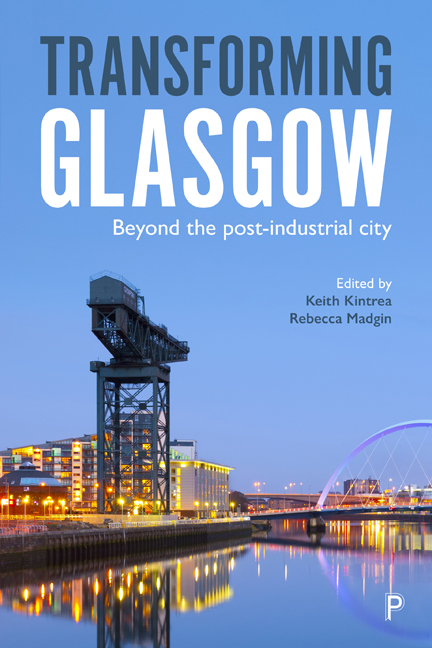Book contents
- Frontmatter
- Contents
- List of Maps, Tables, Figures and Boxes
- Notes on Contributors
- Acknowledgements
- Foreword
- Map
- Introduction: Transforming Post-Industrial Glasgow – Moving Beyond the Epic and the Toxic
- PART I
- PART II
- PART III
- Conclusion: Beyond the Post-Industrial – Narratives of Time and Place
- Index
11 - A Place for Urban Conservation? The Changing Values of Glasgow’s Built Heritage
Published online by Cambridge University Press: 25 March 2021
- Frontmatter
- Contents
- List of Maps, Tables, Figures and Boxes
- Notes on Contributors
- Acknowledgements
- Foreword
- Map
- Introduction: Transforming Post-Industrial Glasgow – Moving Beyond the Epic and the Toxic
- PART I
- PART II
- PART III
- Conclusion: Beyond the Post-Industrial – Narratives of Time and Place
- Index
Summary
Introduction
Glasgow has a reputation as a city that has traditionally shunned its historic architecture in favour of radical new building programmes. However, contrary to popular perception, the city has also gambled on its future by reusing historic buildings to contribute to a number of different urban agendas, including housing, leisure, and health and well-being. The focus on conserving the historic environment that began during the latter decades of the 20th century marked a distinct change from the mid-20th century where it was believed to be ‘a point of pride in the city to destroy and build better’ (Esher, 1971, p 1). This attitude emerged out of Glasgow's infamous policy of comprehensive redevelopment in the 1960s and 1970s which ensured Glasgow's historic architecture was ‘sadly neglected and mistreated’ as ‘very few people saw any merit in Victorian buildings’ (Esher, 1971, p 1). However, during this period a number of influential architectural critics acknowledged the deep sense of loss, both physical and emotional, caused by these policies and started to extol the virtues of the historic environment. The architectural critics, Gomme and Walker, summed up this despair when they stated:
If Glasgow matters architecturally, it matters not only as a collection of fine buildings, but as a great city. The effect of Glasgow, as the effort of some of its best integrated parts, is cumulative. Take away a range of tenements here and there and the effect may only be local; but too much removal and the city will suddenly be a different place. (1968, p 255)
In essence, their call to arms rested on their belief that the city needed a greater awareness of the role that existing buildings, including and beyond those formally protected through listed building status, played in the social and economic life of Glasgow. This chapter develops this thesis as it critically examines the extent to which the historic environment has played a role in Glasgow's transition from de-industrial to post-industrial and beyond. More specifically, the chapter examines the ways in which the benefits of heritage were reconceptualised to satisfy different urban development strategies since the 1980s.
The transition to post-industrial status exposed cities to an accelerated form of adaptation as their traditional industrial base experienced terminal contraction. City strategies to remake places positioned at their core an improvement of the built environment.
- Type
- Chapter
- Information
- Transforming GlasgowBeyond the Post-Industrial City, pp. 221 - 238Publisher: Bristol University PressPrint publication year: 2019



